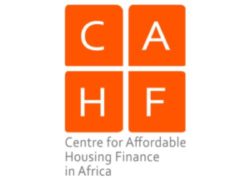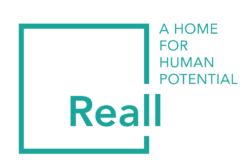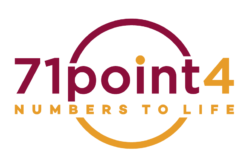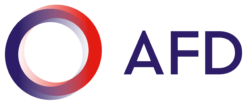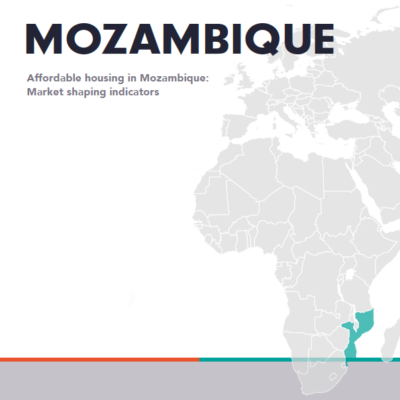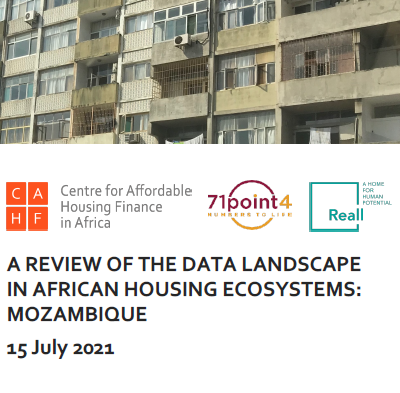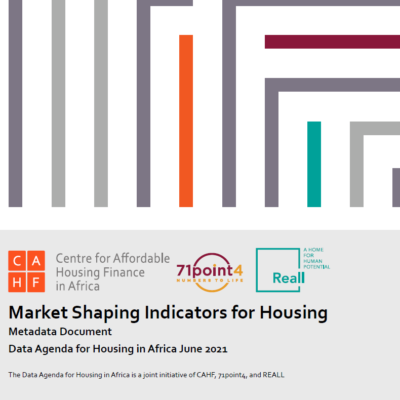Mozambique - Market Shaping Indicators
View Reall projects in MozambiqueReall’s work in Mozambique began in 2017, which formed the basis of its partnership with Casa Real in Beira. Since 2018, Casa Real has leveraged various partnerships to bring innovative and quality affordable homes to Beira’s low and middle income households. CAHF has been working with Mozambique as a priority country since 2015, given the growing need and opportunity to expand access to housing finance products and affordable housing. Together with the yearbook profile, CAHF’s research in Mozambique is an important input into the broader Data Agenda work in Mozambique identifying key gaps in housing market data that would help create a better understanding of the housing ecosystem, for more targeted interventions and policy.
Country Overview
The 2017 Population and Housing Census records approximately 4.8 million formal residential dwellings in Mozambique, and in 2020, 4017 formal houses were reported to have been built. With a rising population, notably in Mozambique’s main urban city (Maputo) the delivery of housing has generally not kept up with demand. In 2018, UN-Habitat estimated that 77.2 percent of the country’s urban population lived in slums, informal settlements or inadequate housing.
The Government of Mozambique’s housing policy is focused on providing better and affordable housing solutions to the lower income population. However, government, through the Fund for Housing Promotion (Fundo de Fomento a Habita – FFH) struggles to meet its objectives due to the high costs involved. More than 90 percent of the population is categorised as low income and, as a result, do not have access to housing loans . The country therefore has limited options for housing loans, and the FFH is the only government institution that promotes low income housing. Only middle and high income households, which account for approximately five percent of the population, can afford housing loans. The majority of families build their own houses incrementally, and approximately 80 percent of the houses in Mozambique are self-built . These houses are built with low quality materials, particularly in the rural areas and near cities, and as a result, the houses are more vulnerable to natural disasters that constantly plague the country.
State of Housing Data
Information on housing finance can be sourced from several institutions such as FFH, the Central Bank, National Institute of Statistics (INE) and commercial banks. However, these institutions do not have specific and detailed reports and data on housing finance. The Central Bank has financing information per banking institution for housing construction, market shares, interest rates, and more, and the information is available on the institution’s website. Banks do not provide detailed information due to compliance and reputational risk. The INE provides detailed information through surveys and general population census. The FFH provides information of ongoing housing projects, house prices, payments, and more. Lastly, the DUAT and property registration information can be found on municipal councils and registry offices, however, the information is superficial and barely updated.
Macro level indicators for Mozambique are largely accessible from government entities and multinational institutions. However, despite existing legislations governing housing related data, there are critical gaps in housing sector data. There are key data concerns for housing construction related indicators some data must be collected through direct correspondence and is not available on the respective websites of government entities. Significant data gaps relating to sales, transfer, and rental of residential properties, further limits understanding of access to finance, home ownership, mortgage credit, housing affordability and property transactions. There is also a lack of downloadable and regularly updated or released data hosted by private entities.
Supporting an agenda for data reporting and sharing in Mozambique’s housing ecosystem, requires concerted coordination and collaboration between market players at the highest level. First, the Bank of Mozambique is well positioned to leverage its network of mortgage and other finance providers to publicly host data related to access to finance. Second, it would be useful for INE to disaggregate some of its real estate data to establish the contribution of residential property to Mozambique’s economy. Third, the Ministry of Public Works, Housing and Water resources (MOPHRH) should be encouraged to centralise housing-related data collected from private housing and construction companies. Furthermore, the Land Registry could develop an electronic database which hosts publicly accessible property transaction data.
Text on this page is based on the MSI Mozambique Country Profile , drawn from Centre for Affordable Housing Finance (2020). Housing Finance in Africa Yearbook: 11th Edition 2020 , with additional content from CAHF and Reall.
Key Indicators
1. Land & Infrastructure
% of urban bottom 40 households without access to basic sanitation services
| Country | Year | Data Source | Value |
|---|---|---|---|
| Cote d'Ivoire | 2012 | DHS | 96.5% |
| Ghana | 2014 | DHS | 93.15% |
| Kenya | 2014 | DHS | 88.25% |
| Morocco | 2004 | DHS | 52.05% |
| Mozambique | 2011 | DHS | 95.6% |
| Nigeria | 2018 | DHS | 83.1% |
| Tanzania | 2017 | DHS | 37% |
| Uganda | 2016 | DHS | 94.5% |
| Rwanda | 2016 | National Institute of Statistics Rwanda (NISR) | 13.13% |
| Pakistan | 2018 | The DHS Program | 2.75% |
| India | 2018 | NSSO 76th Round | 0.2% |
2. Construction & Investment
% of urban population living in slums, informal settlements, or inadequate dwellings
| Country | Year | Data Source | Value |
|---|---|---|---|
| Cote d'Ivoire | N/A | ||
| Ghana | N/A | ||
| Kenya | N/A | ||
| Morocco | N/A | ||
| Mozambique | N/A | ||
| Nigeria | N/A | ||
| Tanzania | N/A | ||
| Uganda | N/A | ||
| Rwanda | 2018 | World Bank | 42.1% |
| Pakistan | N/A | ||
| India | 2018 | NSSO 76th Round | 35% |
3. Sales & Rental
Price of the cheapest, newly built dwelling by a formal developer or contractor
| Country | Year | Data Source | Value |
|---|---|---|---|
| Cote d'Ivoire | 2018 | Site d'annonce et promotion dans l'immobilier en Côte d'Ivoire | 15,500,000 CFA$27,087.48 |
| Ghana | 2019 | Damax Construction Co. Ltd | 108,704 GH₵$19,621.66 |
| Kenya | 2019 | Tsavo Real Estate | 4,000,000 Ksh$37,037.04 |
| Morocco | 2019 | Various real estate websites | 250,000 DH$27,027.03 |
| Mozambique | 2016 | Casa Minha | 3,418,491 MZ$48,147.76 |
| Nigeria | 2019 | Millard Fuller Foundation; Shelter Origins | 2,900,000 NGN$7,651.72 |
| Tanzania | 2018 | CAHF | 37,966,107 TZS$16,508.58 |
| Uganda | 2019 | Various property developers | 125,000,000 UGX$34,097.11 |
| Rwanda | 2020 | Marchal Real Estate Developers | 10,000,000 R₣$11,119.14 |
| Pakistan | 2021 | Partners | 2,500,000 PKR$14,305.33 |
| India | 2022 | Real estate websites and industry experts | 160,000 IN₹$2,176.87 |
5. Enabling Environment
Ease of Doing Business Index Rank: Global
| Country | Year | Data Source | Value |
|---|---|---|---|
| Cote d'Ivoire | 2020 | World Bank | 110 |
| Ghana | 2020 | World Bank | 118 |
| Kenya | 2019 | World Bank Ease of Doing Business | 61 |
| Morocco | 2020 | World Bank | 53 |
| Mozambique | 2019 | World Bank | 74 |
| Nigeria | 2020 | World Bank | 131 |
| Tanzania | 2020 | World Bank | 141 |
| Uganda | 2020 | World Bank | 116 |
| Rwanda | 2020 | World Bank Ease of Doing Business Indicators | 38 out of 190 |
| Pakistan | 2020 | World Bank Doing Business Indicator | 108 out of 190 |
| India | 2020 | World Bank | 63 out of 190 |
6. Economic Environment
GDP Per Capita
| Country | Year | Data Source | Value |
|---|---|---|---|
| Cote d'Ivoire | 2018 | World Bank | 1,024,171 CFA$1,789.82 |
| Ghana | 2019 | World Bank | 11,489 GH₵$2,073.83 |
| Kenya | 2018 | World Bank | 173,272 Ksh$1,604.37 |
| Morocco | 2018 | World Bank | 30,725 DH$3,321.62 |
| Mozambique | 2018 | World Bank | 30,772 MZ$433.41 |
| Nigeria | 2018 | World Bank | 659,159 NGN$1,739.21 |
| Tanzania | 2018 | National Bureau of Statistics; World Bank | 2,297,020 TZS$998.80 |
| Uganda | 2018 | World Bank | 2,357,327 UGX$643.02 |
| Rwanda | 2019 | World Bank | 737,578.59 R₣$820.12 |
| Pakistan | 2020 | World Bank National Accounts Data | 188,900 PKR$1,080.91 |
| India | 2020 | Ministry of Statistics and Program Implementation | 151,760 IN₹$2,064.76 |
7. Demand
Population Size
| Country | Year | Data Source | Value |
|---|---|---|---|
| Cote d'Ivoire | 2017 | World Bank | 24,437,469 |
| Ghana | 2019 | World Bank | 30,417,856 |
| Kenya | 2017 | World Bank | 50,221,473 |
| Morocco | 2017 | World Bank | 36,471,769 |
| Mozambique | 2018 | World Bank | 29,495,962 |
| Nigeria | 2017 | World Bank | 190,873,311 |
| Tanzania | 2019 | World Bank | 58,005,463 |
| Uganda | 2017 | World Bank | 41,487,000 |
| Rwanda | 2019 | World Bank | 12,626,950 |
| Pakistan | 2020 | World Bank National Accounts Data | 220,892,331 |
| India | 2021 | Minsitry of Health and Family Welfare | 1,361,343,000 |
All Indicators
Please enter 3 or more characters to begin search.
You can then click on a result to be taken to the relevant tab.
The Market Shaping Indicators project is a work in progress. Significant gaps exist in data, which will be filled in future revisions. We would recommend checking back regularly for updates. We are keen to receive any feedback that you have on this Dashboard, which can be sent to [email protected].
Using the Dashboard
The indicators are split into 6 key areas, split into the Housing Value Chain: Land & Infrastructure, Construction & Investment, Sales & Rental, Maintenance & Management, Enabling Environment, Economic Environment and Demand, shown in the following tabs. Navigation can either be undertaken by using the tabs, or through the Search box immediately above. Above this, currency indicators can be toggled between USD and local currency.
Users are able to further interrogate each indicator each indicator through clicking on the arrows to the left of each indicator. This expanded section shows the data elements that are used to produce the overall indicator value, dates of data collection, source details, hyperlinks to the original data where possible, and a breakdown of data quality. The majority of indicators are quality assessed, based on the whether they are: Interpretable; Relevant; Sufficiently Accurate; Representative; Timely; and Accessible. Indicators are scored on each of these criteria using a 1-4 star system, detailed below:
☆ – poor
☆☆ – moderate
☆☆☆ – good
☆☆☆☆ – excellent
Finally, all data can be downloaded for further interrogation. By clicking on Switch to Data View at the top of the screen, users can filter data based on countries and columns, and download in a .csv or .xls file.
Bottom 40
Reall targets the Bottom 40% of the urban income pyramid, referred to as the ‘Bottom 40’ or ‘B40’. An objective of the MSI work was to better understand and demonstrate the market from the perspective of households in the Bottom 40, and as such data is aggregated for this group where possible. Data for this group can be particularly challenging to come across. In part, this is due to the difficulties in accurately defining this group using existing data sets. Additionally though, the informality of much of life for lower income groups severely limits data availability, particularly in terms of key data on jobs, housing and relationships with local government. This lack of data is a key blockage for further engagement at the lower end of the housing market, and resolving this is an objective of Reall’s and of the MSI work.
Aggregations
Data is shown at various different “aggregations”, which demonstrate the size and location of the population for which the data represents. This varies from national to city level in terms of population groupings. Additional aggregations exist for the Bottom 40, as detailed above, enabling a focused view on the lower end of the market.
For relevant data, Reall’s partners are also included as an aggregation. This is not meant to be representative of the entire market, but recognises that as practitioners and experts within the lower end of the housing market of each country, their experiences are a useful check on other data sets, and an indication of the value when other data is not available.
Terms of Use
Reall Ltd (“Reallâ€) endeavours to make its data as freely available as possible in order to demonstrate the successes of its model and encourage other actors into the affordable homes movement. Reall provides the user with access to these data free of charge subject to the terms of this agreement.
Users are encouraged to use the data to benefit themselves and others in creative ways.
Unless specifically labelled otherwise, you are free to copy, distribute, adapt, display or include the data in other products for commercial or non-commercial purposes for no cost under a Creative Commons Attribution 4.0 International License, with the additional terms below.  The basic terms may be accessed here. By using or downloading the data, users are agreeing to comply with the terms of a CC BY 4.0 licence, and also agreeing to the following mandatory and binding additions:
– You agree to provide attribution to Reall in any published use of the data, including but not limited to articles, papers, blogs, books. Usage includes both direct publication of the existing data, along with any analysis undertaken by the user. This attribution should include Reall’s name and the following link – reall.net/dashboard. An electronic copy of all reports and publications based on the data should be shared with Reall ([email protected]).
– When sharing or facilitating access to the data, you agree to include the same acknowledgement requirement in any sub-licences of the data that you grant, and a requirement that any sub-licences do the same. You may meet this requirement by providing the uniform resource locator (URL) to these terms of use.
– Some datasets and indicators may be provided by third parties, and may not be redistributed or reused without the consent of the original data provider, or may be subject to additional terms and conditions. Where applicable, third party data is labelled as such, and usage conditions can be found on their respective websites.
Land
In Mozambique, all land belongs to the Government, therefore, it cannot be sold, pledged, or mortgaged against . Access to land is granted through an official document that concedes the right to use and exploit a specific land or plot, the Land Use and Exploration Rights (Direito de Uso e Aproveitamento de Terra “ DUAT), which is issued to both individuals and companies.
Mozambique s DUAT system is inflexible and makes land expensive in the informal market, particularly in the expansion areas of the metropolitan part of city. In 2018, the Government approved a new Property Registration Act replacing the previous one in force since 1967. The new law was established to increase the efficiency and quality of public services by installing electronic platforms for notaries and land registry offices as a way of bringing services closer to companies and citizens . On 16 June 2020, the President launched an official hearing to review the national land policy, seeking to adjust it to the current social and economic dynamics and stimulate private investments. However, sole proprietorship of land and natural resources will remain with Government ³.
With respect to land titling, the government launched the Terra Segura/ Secure Land project in 2015, together with the World Bank and other stakeholders to ensure the massive acquisition of DUAT s (right to use and benefit from land), and under this programme over 470 000 DUAT s have been issued. Mozambique ranks low (7.5) in the World Bank s quality of land administration index, which measures five dimensions: reliability of infrastructure, transparency of information, geographic coverage, land dispute resolution, and equal access to property rights. Overall, Mozambique s global ranking for registering property is 136 out of 190 countries, indicating an environment that is not very conducive for property registration.
Infrastructure
Households spend 18 percent of their budgets on transport, and this spend often reflects the distance and accessibility between dwellings and city centres. Poor service delivery is commonly experienced by Mozambique s urban dwellers. More than half of Mozambican households have no access to basic sanitation and electricity services and 44 percent are without access to basic drinking water. While the government s 10-year housing project may improve the availability of land and basic infrastructure, the provision of sufficient and quality services is limited for many households who self-build.
Of the 23 indicators in this group, 10 are currently populated.
Supply
Most houses are built incrementally, and approximately 80 percent are self-built .
The œHabita 10-year program was established in 2019 to ensure decent housing solutions to Mozambican households and together with the FFH program aims to build 44 265 houses by 2024, of which 60 percent are to be allocated to the low income segment that earns between MT4 266 (US$60) and MT21 333 (US$301) a month. As part of the same program, the Minister of Public Infrastructure, Housing and Water Resources, Joao Machatine, recently launched the œRenascer project in Maputo province, district of Manhiça, with the objective of building 300 houses for the low income segment in rural and urban areas of Maputo, Nampula and Cabo-Delgado provinces . The project is estimated at MT240 million (US$3.3 Million) and targets government employees and young people in early career stages. Houses will be built on the land of the beneficiaries, followed by a monthly payment of between MT1 500 (US$21) to MT2 800 (US$40) a month, for 20 years without any interest ³. The project is being implemented in partnership with the city councils and a few districts. In the first phase, 30 low income homes were built for young citizens in the municipality of Manhica: see attached. The second batch of 22 houses were completed in February 2021 in Nampula province: see attached, and there are plans for additional houses to be constructed in Maputo City and Cabo-Delgado Province. Meanwhile in Beira, the municipality is developing a project with the aim of building 25 000 houses in Maraza, on a 400 hectare plot, and construction will be carried out by the private sector, who will invest in affordable housing models for low income households.
Despite the FFH s objective to provide affordable housing for low income households, many housing projects developed through public private partnerships benefit only the middle and high income segments: see policy, such as the Intaka project and, more recently, Zimpetos Olimpic Vila see attached.
Data from 2000 showed that 60 percent of construction materials were imported: housing profile pdf. In line with the Constitution, which grants the right to housing ¹, and due to the absence of projects that provide housing for the low income segment, the Government is preparing tax benefits for importing housing construction materials °.
Investment
The private sector does not invest in the construction of houses due to high interest rates from the banks, which the Central Bank has had limited success in reducing .
Of the 19 indicators in this group, 7 are currently populated.
Property Markets
Nationally, ninety percent of the Mozambican population own a house, and only 6 percent live in rental housing . At city level though, the demand for rental is significant, with over 23 percent of Maputo’s households (approximately 54 000 households) renting a house in 2017. While most of the population cannot afford the costs associated with buying an adequate house, the rental market is typically dominated by high income individuals, mainly investors and expatriates.
Apart from the Fundo Para O Fomento De Habita £o (FFH), created in 1995 with the objective to make housing affordable for all social segments, there are few legally established housing providers. There are public private partnerships dedicated to the construction of houses, and agents that undertake the selling and rental process, however, most households rely on self-construction. The Government, through the FFH, designed several housing projects but only a few were implemented (such as the Intaka and Vila Olmpica projects) and mostly benefited the middle and high income class. The Zintava apartments cost MT3.6 million (US$51 000) and MT4.2 million (US$60 000) . The FFH has built 4 017 houses and divided 13 176 plots ³.
Mortgages
Currently Mozambique has 19 banks, eight microbanks, eight credit cooperatives, three electronic money institutions, one financial lease institution and one investment company see attached. The Central Bank data from June 2020 shows that the Mozambique International Bank (BIM), Commercial and Investment Bank (BCI) and Standard Bank have a combined share of 66 percent. Despite the expansion of financial services and the number of banks operating in the country, financial inclusion remains a challenge. Data from the 2019 FinScope Consumer Survey shows that 79 percent of the population does not have a bank account, of which 22 percent have access to financial services through non-banking mechanisms, 11 percent rely on informal mechanisms and 46 percent are completely excluded Mozambique Survey. Most banks have a housing credit line, which includes the options of purchase, rehabilitation and construction, but this mainly benefits middle and high income groups, mostly made up of government and bank employees. Mortgage market growth has been low (accounting for less than a percent of GDP), and in 2017 housing finance was only 2.97 percent of the total loan book: housing profile.
Mortgages are typically long-term with maturity of 12 to 25 years. Clients must have a down payment of 10 to 30 percent (typically 20 percent), and normal interest rates for housing loans vary from 16 to 23 percent. In 2020, the prevailing mortgage rate was 20 percent. These high rates from commercial banks on housing loans are linked to an inherent market risk and therefore the banks proceed with caution, effectively excluding the majority of low income households from accessing the formal housing finance market. Mozambique is estimated to have only 600 outstanding mortgages. Those with formal employment and income that qualify for banking loans often opt for short term loans capped at MT1 500 000 (US$21 210), and up to a five year term, with an interest rate of 16 to 27 percent. Despite the amount being enough to build a modest house, very few people have the capacity to pay for such a loan as loan payments cannot be higher than 30 percent of the borrower or household income.
Central Bank data shows that, despite the impact of the pandemic on the economy, the amount of housing credit by private banks reduced by only one percent between the first half of 2019 and the same period in 2020, from MT50 210 793 (US$709 994) and MT49 829 754 (US$704 606) respectively : see link. Disaggregated data on credit for construction, purchase or rehabilitation of housing is not available.
Affordability
The FinScope Survey showed that most of the adult population (52 percent) had a monthly income below MT5 000 (US$80). The Survey also stated that 19 percent of the adult population worked in agriculture: Consumer Survery, which is the sector with the lowest minimum wage, at MT4 390 (US$62) compared to MT12 760 (US$181) in banking and insurance. The average price of the cheapest, newly built house, MT700 700 (US$10 000), is affordable to 4% percent of urban households through widely available finance products, and is constructed by Reall partner, Casa Real, in Beira. However, Casa Reals tenant purchase scheme significantly widens the population that these homes are affordable to. This is compared to a typical price of what is considered a relatively affordable home in Mozambique, MT2 659 000 (US$37 947), which is affordable to only 1.5% of the population. Houses built under the FFHâ s Intaka Project are also costly and unaffordable, with an average price of MT2.6 million (US$37 000).
Of the 40 indicators in this group, 12 are currently populated.
Most of Mozambiqueâ s low income population do not have access to finance due to the absence of assets and property in their name to be used as collateral, along with the absence of steady, long term employment. Although unsecured microcredit supports the incremental construction process of low income households, overall the loan amounts of Mozambiqueâ s eight microbanks and microfinance institutions (MFIâ s) are low and mainly channelled to rehabilitation or construction of houses, and require other guarantees apart from the house, with a maturity of six months to three years. MFIâ s also have higher rates than commercial banks. Improvements to dwellings is only one percent of household expenditure, and given poor housing conditions in Mozambiqueâ s main cities, this signals the limited resources at the disposable of most Mozambicans.
Of the 6 indicators in this group, 3 are currently populated.
In Mozambique, providing housing to the low income population is part of the fundamental housing policy strategy. However, in reality, most of the population is excluded due to high costs and strict requirements to access finance. There is no housing market platform where financiers, promoters, builders, brokers and clients meet and interact. Real estate activities are concentrated in the capital, and housing is mostly available to middle and high income households.
Mozambiqueâ s Human Development Indexâ s global rank is 181 out of 189, putting it in the low human development category. The countryâ s 2020 Ease of Doing Business score of 55.0 places it at 138th of 190 countries, though this is an improvement from 2019, when it scored 54.6.
In northern Mozambique (Cabo Delgado), terrorist attacks continue to severely impact the population. This insurgency is linked to the discovery of offshore gas, which is important for increasing growth prospects in Northern cities (Tete, Pemba, and Nampula). In many districts, houses have been burned, and people beheaded and abducted. This has resulted in destruction and displacement . Over the past two years, the attacks have resulted in the deaths of at least 700 people and caused a humanitarian crisis impacting 211 000 people . This scenario accentuates the housing deficit in the country.
Of the 6 indicators in this group, 2 are currently populated.
Mozambique is a developing country located in Southern Africa, with approximately 50 percent of the population living below the poverty line. Gross domestic product (GDP) per capita (US$503) has remained steady in recent years, as has its unemployment rate of 25 percent.
Over the past four years, the Mozambican economy has not had satisfactory growth when compared to 2015, when the annual growth rate was at eight percent, mainly driven by the exploitation of natural resources, specifically natural gas and mineral coal. Between 2016 and 2019, the annual growth rate was three percent a year , which was one of the lowest ever recorded. With the impact of COVID-19, the Central Bank (Bank of Mozambique) expects an annual growth rate of under 2.2 percent (registered in 2019) but does expect a recovery from 2021 . On 30 March 2020, Mozambique declared a State of Emergency for 30 days as part of a series of measures to contain the pandemic, and extended the period several times. A lockdown was not enacted. To reduce the impact of the pandemic on the economy, and also to maintain control over consumer prices, the Central Bank adjusted the policy rate and the prime rate in line with the economic outlook and inflation. The current rates are 10.25 (from 11.25 percent) and 15.9 percent respectively ³. Inflation was 2.78% in 2020 and expected to remain at a single digit in 2021: see link.
The Central Bank made a line of credit of US$500 million available to commercial banks to reduce the impact of the pandemic. In addition, it also reduced the commercial banks statutory reserves for default loans: see link. Through the National Investment Bank (BNI), the Government launched the BNI COVID-19, a funding program with preferential rates for small and medium enterprises affected by the pandemic. The interest rates vary from five to 12 percent and are lower than commercial bank rates of 18 to 21 percent: see link.
Of the 14 indicators in this group, 9 are currently populated.
Mozambique has a population of approximately 30 million people (a 33 percent increase over the last 10 years). Nationally, there are approximately 6.3 million households in Mozambique, and of these, 38 percent make up urban households. The average household size has not changed significantly over the last ten years – the average household size was 4.4 in 2017, compared to 4.8 in 2007. Mozambiqueâ s urbanisation rate (4.4 percent) is higher than that of the Southern African region (3.1 percent) as a whole. The countryâ s urbanisation and population growth rates (2.9 percent) continue to put pressure on housing needs.
Of the 7 indicators in this group, all are populated.
